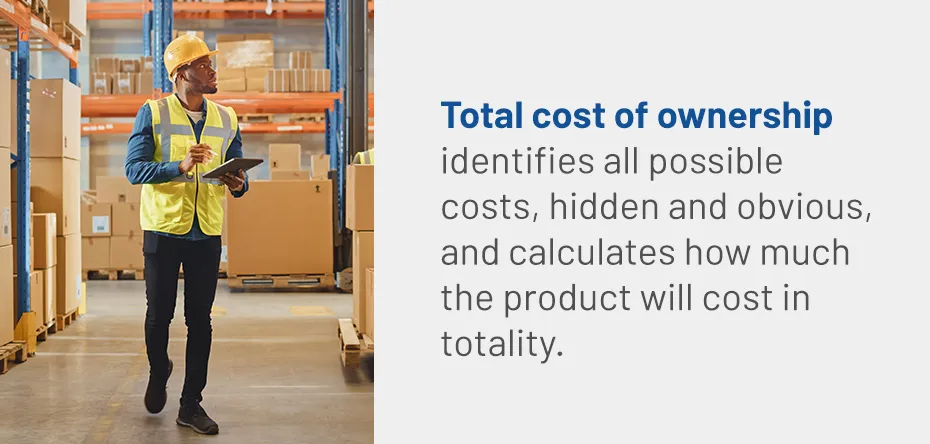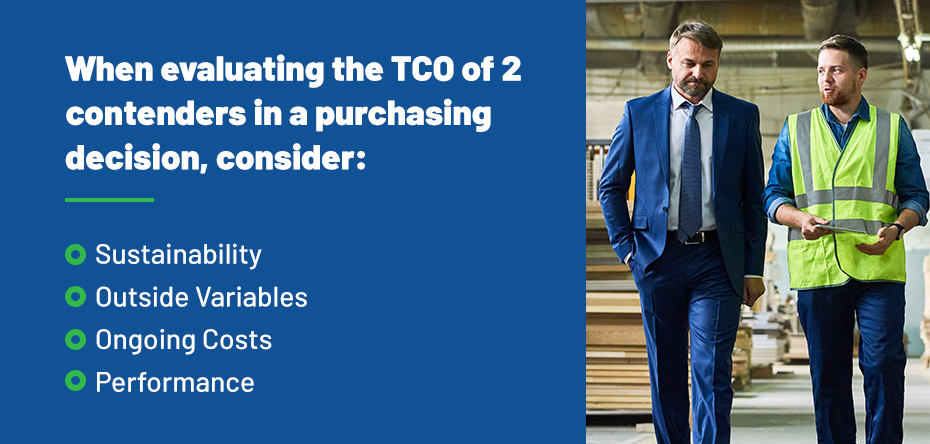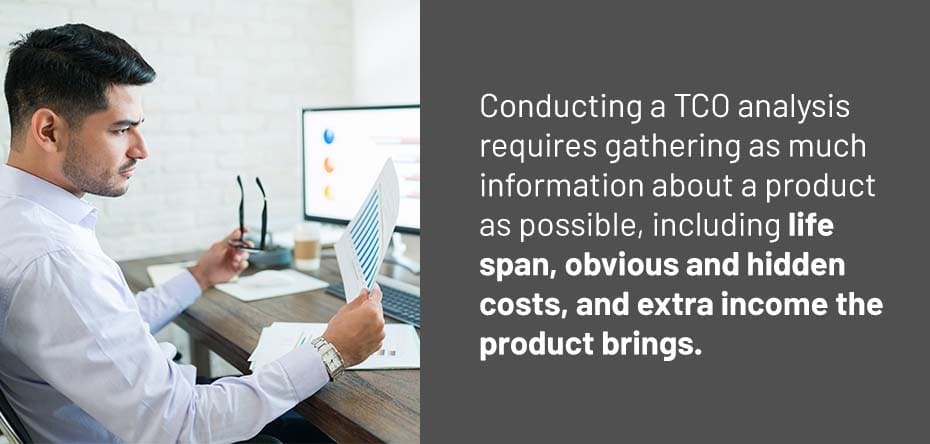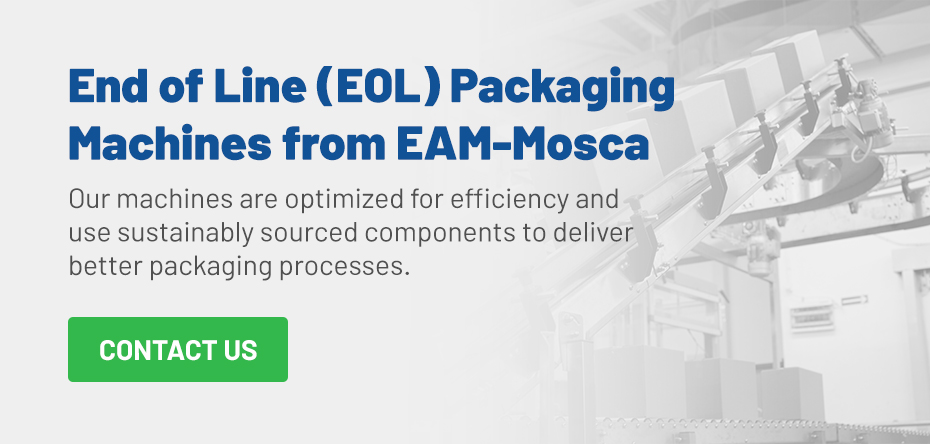What Is Total Cost of Ownership in Manufacturing?
Initial purchase price does not reflect the total value of an item. The total cost of ownership (TCO) is useful in comparing machinery for a manufacturing facility. This metric combines several factors of owning and operating a piece of machinery for a full picture of the cost of lifetime ownership. Make more informed and wiser investment decisions for your manufacturing facility equipment using TCO as a factor.
What Is the Total Cost of Ownership?
Purchase price of an item does not indicate whether it’s a good investment. Low purchase prices may come with short life spans or high maintenance costs. Higher-priced items may last longer or need less servicing. The total cost of ownership provides a complete picture of the quality of investment.
TCO uses data on all aspects of buying and using a product to give a realistic estimate of how much a company will spend throughout the duration of its life. It includes the hidden costs of using equipment, which may encompass expenses related to daily operation, maintenance, and training staff to run it. These hidden values may be a sizable percentage of the overall TCO.
Total cost of ownership provides a means to determine the return on investment (ROI) of buying a product. Comparing the ROI on various products ensures that you make a value-based investment in the option you choose.
Total Cost of Ownership vs. Price
Price only gives one part of the total picture when purchasing equipment, as it indicates the initial investment but not the cost of owning and operating the product. Comparing prices alone does not account for goods that could have higher operating costs, demand more training, require frequent maintenance, or have shorter service lives. Even if these products cost less initially, they will produce a higher financial burden over time.
Total cost of ownership identifies all possible costs, hidden and obvious, and calculates how much the product will cost in totality. Another term used for TCO is the asset life-cycle cost, which refers to the calculation accounting for all expenses associated with the product during its useful life.
For example, two strapping machines for the packaging line of a manufacturing company may have the same price. Sales and discounts can make some products cheaper than others for the initial purchase. In some cases, lower-quality parts reduce the purchase price. Knowing the TCO is useful to gauge the differences in the value of each product over time.
After analyzing the TCO for each, say product A has a much lower TCO due to lower maintenance costs, longer service life, and better customer service availability. Product B, despite having the same purchase price, may cost more to operate over time since it needs more frequent repairs and maintenance and can be expected to wear out more quickly.
Only by using the TCO can you get the impression of the return on investment your facility will reap from buying a product. Better data will lead to more informed decisions that provide long-term benefits for the facility while keeping operating costs down.
Who Should Use TCO Analysis?
The popularity of TCO analysis appeared during the 1980s when companies began to invest heavily in IT hardware and software. At the time, participants in the highly competitive IT marketplace needed means of differentiating their products from others. Companies would claim that other producers made software and hardware that had high operating costs. However, when calculated, the TCO for nearly all IT solutions at the time was several times higher than the purchase price.
Today, many industries have embraced the use of TCO when integrating technological solutions into their operations, such as the following:
TCO in the IT Industry
The benefits of determining total cost of ownership continue to be relevant in the IT industry. Companies must look at the prices of acquiring and activating software as well as how much keeping it updated will cost. Plus, they must determine the time needed for training employees in using the software, updating IT staff on troubleshooting it, and whether the facility needs hardware updates to accommodate it.
TCO for Real Estate
Total cost of ownership often comes up in making improvements to real estate. For example, a building may need to determine whether to add solar panels to a roof. The cost will be higher than standard roofing material. However, the solar panels will generate electricity, which lowers power bills. The exact value of the investment will depend on how much power the panels can create versus how much the building needs.
Similar green upgrades, such as energy-efficient or water-efficient appliances, also require TCO analysis to see how much these investments will benefit the building over time.
Transportation and TCO
Companies choosing to invest in fleet vehicles or other transportation often use TCO to determine the best type to buy. For instance, a company may need to decide between using electric or gas-powered vehicles for their fleet. The former may cost more initially, but they don’t incur fueling costs that vary with the price of gasoline. Plus, the electric models produce less pollution. Choosing more eco-friendly fleet vehicles may improve the company’s reputation and lower operating costs of the fleet, which could improve profits.
Manufacturing Total Cost of Ownership
Automation is increasingly popular for upgrading productivity in manufacturing facilities. However, not all automation solutions yield the same ROI. For example, when choosing automated options, such as strapping machines, the facility needs to determine how much they can save by upgrading to machinery to do the job instead of having people strapping packages or using older, less efficient technology.
Why Use Total Cost of Ownership? What are the Advantages?
The benefits of using the total cost of ownership include this method’s ability to compare sustainability, risks, ongoing expenses, and performance of various products or services. These parameters make it possible to choose the best investment for the long term. To go beyond price and evaluate the TCO of two contenders in a purchasing decision, look at the following:
1. Sustainability
The impact of using a product extends beyond a company. Sustainability is important in finding out the effect using a product has on the environment and supply chain. For example, electric vehicles promote sustainability because they don’t rely on fossil fuels, which represent a finite resource.
In manufacturing, sustainable products will have materials sourced responsibly or those that can be recycled. Strapping machines that use 100% recyclable polyester (PET) strapping materials are one instance of a sustainable option for automated solutions at a manufacturing facility.
2. Outside Variables
TCO examines purchase price as well as all the other variables involved in owning and operating a product, including employee training, transportation, materials, installation, delivery times, and operational costs. Industry-specific variables are also part of the TCO analysis. For instance, the cost of permits for installing solar panels on a building would be factored into the final TCO for a solar project.
3. Ongoing Costs
Ongoing expenses can surpass the purchase price, especially for durable products that last for years. When you’re determining TCO, be sure to account for costs such as supplies needed to operate the equipment, training new and existing employees in its use, and maintaining it.
4. Performance
The performance of a product will impact its TCO by contributing to repair and maintenance costs, longevity, and operational downtime. The less reliable a product is, the more costly it will be due to its poor performance. Quality products that perform efficiently reduce the total cost of ownership.
The Costs in TCO
Some factors have a greater influence on TCO than others. For instance, ongoing maintenance costs have a significant impact on TCO for manufacturing machinery, as a machinery purchase should operate as long as possible and require little maintenance that could bring a halt to operations. Depending on your industry, these expenses may require heavier weighting in determining total cost of ownership:
1. Acquisition
Acquisition costs include more than the purchase price. This component of TCO extends to the delivery, installation, and setup fees to get the product in place and running. For manufacturing machines that connect to system-wide management and control software, the cost of the software or upgrading it to work with the new product is another component of acquisition.
For instance, supervised installation and setup from the manufacturer of a strapping machine reduces the chance of issues that could increase acquisition costs. Plus, this type of support reduces the time needed to get the machinery integrated into the packaging line and contributing to productivity.
2. Operation
Operating costs for manufacturing equipment include the productivity of the machinery. Highly productive machines may have premium costs but will save time and money in the production process. Not all equipment needs to have the highest productivity levels. For example, smaller facilities that only need strapping equipment during high-demand seasons may benefit from operator-cycled machines instead of fully automated models. Manufacturers that need higher volumes have more to gain from fully automated strapping machines.
3. Personnel
Personnel costs include training employees on the new equipment and ongoing training to keep workers updated on any changes. If a machine needs additional staff to operate it, maintain it, or train others in using it, the cost of hiring those workers also goes into the personnel category.
4. Ongoing Maintenance
Maintenance costs are a major component of TCO for manufacturing equipment. For strapping machines, the equipment needs a long life expectancy. Upkeep should require few replacement parts and maintenance needs. For instance, strapping machines from EAM-Mosca use direct drive brushless motors to reduce replacement part needs. These attributes decrease downtime, which can be a significant contributor to total maintenance costs.
Plus, our services include both technical support and continued machine performance support with predictive and preventive maintenance options.
Steps of a TCO Analysis
Conducting a TCO analysis requires gathering as much information about a product as possible. This data should include life span, obvious and hidden costs, and extra income the product brings. Once you have these figures, compare the results to find the best product or program for your facility.
1. Determine Length of Ownership Life
One way of calculating TCO is determining the product’s average length of ownership life. Then, divide the costs you identify over that life span to find out how much the product will cost annually.
Another way to use ownership life for TCO is to use a set period of time, such as 10 years, to better compare costs of operation and maintenance. Using a predetermined life span makes it easier to directly compare products that have different life expectancies.
2. Categorize Obvious and Hidden Costs
Identify the obvious costs such as maintenance and purchase price, then consider hidden costs such as part replacement, disposal, installation, personnel training, insurance, reconfiguration, and financing costs. Categorize both hidden and obvious costs into how much they impact the TCO. For instance, maintenance costs will often impact manufacturing equipment TCO more than the purchase price.
Additional support for your equipment, like that provided by EAM-Mosca, helps lower TCO by reducing your need to find third-party installation, training, or setup services. Plus, with our company-provided service for our products, you have the luxury of asking questions before problems occur, thereby reducing potential maintenance or repair issues that could lead to downtime.
3. Account for Additional Income
When upgrading manufacturing equipment, calculate into the TCO how much the new machinery will increase productivity and profits. Incorporate the extra income into the TCO to reduce the overall cost and show the return on investment you can expect from the machine.
Another source of additional income to lower the TCO is the value remaining in the product after the first five years. Machinery that keeps its value can resell for higher prices if your facility needs to upgrade. Plus, higher value retention is indicative of well-made products designed for long-term use.
4. Choose a Product
Once your TCO analysis is complete, you should be able to identify the best product for your operations. Since the purchase price is usually such a small percentage of the TCO, the cheapest machine may not be the one with the lowest owning and operating costs.
With TCO analysis, you can find the product that will provide the greatest monetary and productivity benefits for your manufacturing facility. For example, a strapping machine made with innovative, sustainable components and efficient systems lasts longer, requires fewer replacement parts, needs less maintenance, and provides a better ROI than other options, with the benefits becoming clearer throughout the machine’s service life.
Contact EAM-Mosca Corporation for More Information on Our Packaging Line Machines
EAM-Mosca Corporation produces banding and strapping machines for the packaging phase of manufacturing. Our equipment uses the latest innovations to ensure a high-quality design and exceptionally long service life. We also optimize the TCO of our equipment by offering lifetime support and services.
Our machines are optimized for efficiency and use sustainably sourced components to deliver better packaging processes. Contact us today to find out about our products and how our commitment to ongoing service makes our packaging equipment a contender in any TCO comparison.






